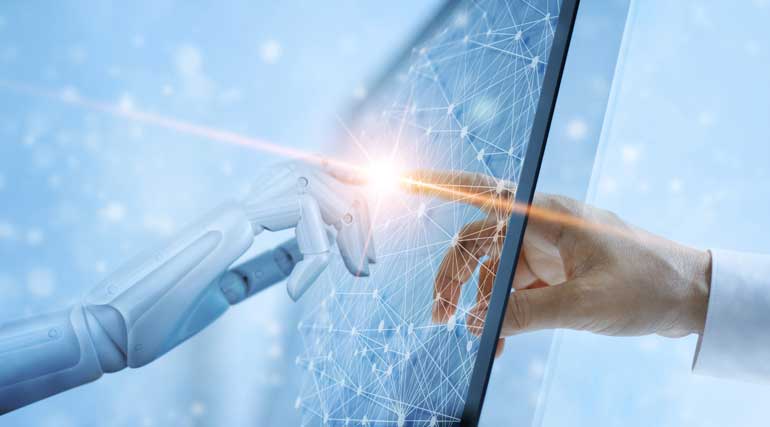“AI,” “IA.” It almost sounds like something that could be part of the children’s classic song “Old McDonald Had a Farm.” Yet, even though artificial intelligence (AI) and intelligent automation (IA) can be somewhat of a tongue twister, the real confusion lies in what these technologies do and the differences between them.
Taking a closer look at these technologies and concepts will help to resolve any confusion or misconceptions.
What Is Artificial Intelligence?
AI is a group of technologies that work and respond like humans. From machine learning and natural language processing to speech recognition, AI technology enables machines to understand, operate, and learn—helping to maximize efficiencies, decrease human error, and accelerate time to market. AI is designed to replace human activity in manual operations.
Additional business benefits of AI include:
- Increasing agility
- Allowing enterprises to innovate and grow
- Reducing complexities within systems and operations
For most companies, artificial intelligence is a part of their IT department’s vernacular. AI has been around for many decades, although recent advancements in technology mean it has evolved. The transformation of AI from something most people perceived of as “robots coming alive” to how it applies to businesses today has encouraged investors and business leaders across every market to explore it for its potential to revolutionize their operations.
How Is It Used in Business?
AI has applications across every industry. In healthcare, for example, AI can help service providers diagnose patients earlier with better diagnostic tools. In finance, it can help with fraud detection. Manufacturing businesses can improve logistics by using AI for better inventory management. And smart meters and smart grids employ AI to improve our utility usage.
AI now touches consumers at every turn in their relationships with businesses. Chatbots, for example, use AI for customer service. The natural language processing mentioned earlier is used in interactive voice response systems to help customers over the phone. Artificial intelligence fully supports functionality such as machine learning, natural language processing, cognitive document processing, and other “learnable” functions. These functions are valuable because they free humans to focus on more strategic, valuable tasks. A 2018 study on AI reports that 60 percent of C-level executives surveyed say their organizations plan to increase investment in AI by over 50 percent compared to the last year. This rise demonstrates just how valuable AI is to industries of all sizes.
What Is Intelligent Automation?
Intelligent automation connects separate automation technologies and is more of a concept than technology or solution. IA includes technology such as Robotic Process Automation (RPA), process orchestration, artificial intelligence, analytics, mobility, and information management. The key distinction between the two is that AI is part of IA. Think of IA as the umbrella under which AI and its cohorts live.
Intelligent automation helps humans perform actions they would not be able to without the help of a computer, and it helps them amplify their existing intelligence. By contrast, AI helps machines become autonomous and removes the human need for involvement. This second crucial distinction when identifying AI versus IA is the amount of human activity involved. For example, IA would provide information and data to a human so that human could improve a process. AI would remove the need for a human to be a part of a process.
IA is a game-changer in almost every industry around the globe –– helping businesses with efficiency, quality control, and their overall operations. In fact, Deloitte warns that companies that fail to include intelligent automation in their work processes will be left behind.
How Is It Used in Business?
Intelligent automation allows us to turn enormous amounts of data into information that is validated and can be processed with as little human interaction as possible. Whenever there are changes to any core enterprise applications, IA can help in identifying which business processes are going to be affected. And IA can give humans information that helps them both amplify their intelligence and remove themselves from tasks that can be automated.
For example, IA can help a business with tasks such as applying for a new mortgage or a new account opening. All of this can be done from a mobile device or computer where the applicant submits data through an online form that includes appropriate validations prior to submission. A picture from the mobile device can extract data from a driver’s license as well as compare the facial recognition of the picture on the license and the selfie the person takes at the same time. RPA technology can use the captured data to go out to the web and gather additional details and/or documents about that person that would be required as part of the process. Once all data and documents have been gathered, AI can evaluate the data and determine the next step in the process and who needs to be a part of that step. Workflow or process orchestration then allows the data, documents, and tasks to be presented to the appropriate users. Once complete, the appropriate notifications and documents can be sent automatically to the applicant. If a signature is required, the applicant can sign the document electronically or on the printed document. Using the mobile device, the applicant can take a picture of the signature page and submit that to complete the process. This description includes all facets of technology that get wrapped under the IA umbrella and are part of a true IA platform versus cobbling together separate technologies and having to integrate them.
IA unites information management, automation, and other “thinking” tools to boost productivity. Understanding that all these moving parts serve an essential function will help in identifying the key differences. For example, AI activates RPA when required to automate what would be a manual user task. In this scenario, RPA is the action portion of this process. The takeaway here is that AI cannot exist on its own. AI needs RPA to produce optimal results, and RPA needs the other IA technologies since RPA’s primary function is to automate manual tasks otherwise performed by humans.
Conclusion
It’s important to note that AI and IA are not just buzzwords or a passing trend for large enterprises. Instead, these technologies are proving to be valuable components in addressing scale and complex processes — two of the biggest challenges for most enterprises. They have moved past their hype cycles and are here to stay to change the face of business operations across all industries and with companies of all sizes for the foreseeable future.






